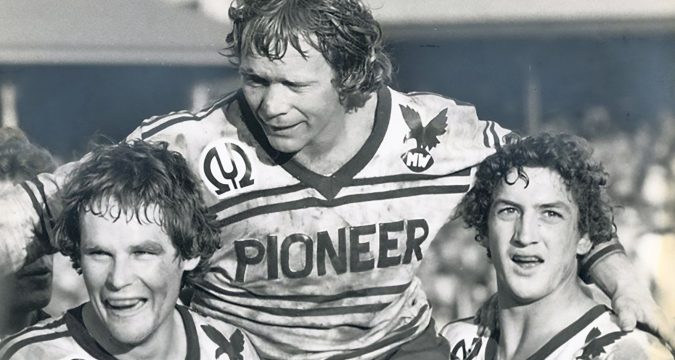
As part of our celebration of the 500th issue of Rugby League World, we survey the Australian scene from when it launched as Open Rugby in 1976.
LET’S climb aboard the time machine and head back to 1976, when Harry Edgar was writing the first pages of Open Rugby and take the long-haul flight to a land down under in the midst of ABBA fever and a rugby league scene that hadn’t expanded beyond two cities at the elite level.
Regional rugby league was alive and kicking, however 12 Sydney-based clubs, fuelled by poker machine earnings, held the power and were able to attract the best talent to the competition then known as the New South Wales Rugby League.
While ABBA’s hit single Fernando was one of the best-selling songs of the year, it was the Manly Sea Eagles, a team from Sydney’s picturesque northern beaches, dubbed the ‘Silvertails’ by coach and journalist Roy Masters, and proud ‘westies’ Parramatta Eels based in working class Western Sydney that topped the NSWRL ladder respectively at the end of the regular season.
Parramatta had the edge, winning the semi-final 23-17 against Manly after narrow victories over their enemy during the season. In Rugby League Week magazine journalist Geoff Prenter reported on the semi-final with the headline ‘Manly – go to (Parra) jail!’ Manly, captained by ‘NRL Immortal’ Bob Fulton put on an aggressive display.
Prenter went on to say “Old timers in the (SCG) Members Stand could not recall a more popular win nor a more popular defeat.” It would be fair to say Manly Warringah were not the most well-liked club outside of the northern beaches.
However, a Grand Final is a different beast and Manly containing three Englishman, Phil Lowe, Steve Norton and Gary Stephens, were able to turn the tables on the Eels.
Prenter described the 13-10 Manly victory in front of almost 58,000 fans as “one of the great Grand Finals. It completely erased the bitter memories of Easts 38-0 win over St George last year”. Prenter said “Gary Stephens, despite two costly penalties, had a big hand in the win. Norton and Lowe (who scored Manly’s only try) were inspiring. In fact, it was a great day for the English.” The match will be remembered for Parramatta winger Neville Glover dropping the ball with a wide open try line and 10 minutes of the match remaining.
A post Grand Final story from Prenter revealed Parramatta player John Peard was on the dole and looking for work. How times have changed!
At the same time as the NSWRL title was decided, the other Australian major rugby league competition in Brisbane was drawing to a conclusion. Due to a state ban on poker machines, Queensland clubs didn’t have access to the same level of funds to attract players. Locals would argue the Brisbane Rugby League competition was just as strong. A number of players turned down offers to go to Sydney, putting a relaxed lifestyle ahead of earning more money.
It was Wests v Easts in the BRL Grand Final finishing with the unusual scoreline of 16-1 in favour of Wests in front of a capacity 35,000 strong crowd at Lang Park. John Ribot, later to become CEO of Super League (Australia) scored a try for Wests.
Two years earlier Colin McLennan introduced a made for television midweek cup competition, known as the Amco Cup, played under floodlights at Leichhardt Oval (home to the Balmain Tigers) with four 20-minute quarters. The competition enjoyed immediate success, attracting 35 teams in 1976. The teams came from Sydney, NSW country, Brisbane, QLD country, New Zealand and the Northern Territory.
The 1976 Amco Cup final, won 21-7 by Balmain, was played in front of 21,652 people while many more fans were glued to the television at home. Commentator Ray Warren, writing in Big League magazine, made mention of a flick pass leading to a try that became a trademark move involving Englishman Brian Lockwood and Neil Pringle at the Tigers. He felt sorry for John Gray and North Sydney who hadn’t won a first-grade title since 1922. The teams were competing for a total of 55,000 Australian dollars with Balmain taking $40,000. Money, Money, Money indeed.
State of Origin wasn’t implemented until 1982, meaning in 1976, NSW with access to the best players (selections based on current club), won the Interstate series 3-0 against Queensland.
Rugby league magazines played an important role in keeping the fans informed and the aforementioned Rugby League Week and Big League motivated this correspondent to rush to the newsagent first thing on a Wednesday morning. Both publications have been discontinued, however Rugby League Review magazine, whose owner Terry Liberopoulos was inspired by the two Australian magazines and Rugby League World, commenced in 2002 and remains undefeated.
Happy 500th issue Rugby League World from Australia. Here’s to many more fabulous editions.
First published in Rugby League World magazine, Issue 500 (September 2024)
Click here to subscribe to the print edition of Rugby League World
